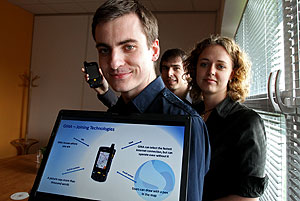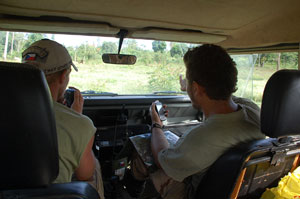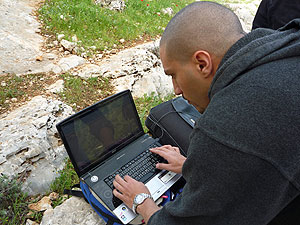REDMOND, Wash. – July 1, 2010 – When a catastrophic earthquake struck Haiti on January 12, rescue teams around the world started to mobilize. One group preparing to head to the devastated country was Hand for Help, a humanitarian organization based in the Czech Republic.
Before leaving for Haiti, Hand for Help received a call from three students at the nearby Brno University of Technology. The students proposed that the group use a new mapping software program they had built to compete in the upcoming Imagine Cup competition.
The emergency responders took the program and used it to stay connected as they traveled across Haiti’s rough terrain. The Geographical Information Assistant (GINA) allowed the rescue workers to use their personal digital assistants (PDAs) to do things like overlay emergency locations on multiple maps, pull global positioning system coordinates for the places they needed to go, and use touch technology to make notations on their maps.

Czech Republic students (from left) Zbynek Poulicek, Boris Prochazka, and Petra Bacikova show off their Geographical Information Assistant (GINA), which helps rescue workers coordinate with each other and navigate difficult terrain.
Today Hand for Help is still in Haiti, using GINA to help build a field hospital outside Port-au-Prince and navigate roads and rugged terrain throughout the country.
Meanwhile, the students behind GINA are preparing to represent the Czech Republic at the Imagine Cup World Finals in Warsaw, Poland. The Microsoft-sponsored student technology competition, the world’s largest, culminates July 3-8 as teams from around the world compete for the top prize. Part of a growing trend in Imagine Cup competition, the Czech students and others competing in this year’s event are entering projects that are already helping solve problems around the world.
For its part, the GINA team hopes to use the competition as a way to get its project into the hands of rescue workers worldwide. Before the Haitian earthquake, GINA had just been another school project they were working on to help people track each other on a map, the students say. Then they realized GINA could help people in need. Now they view Imagine Cup as a launching pad to do a lot of good.
“The best result for us is that our software helps rescue workers save lives,” says Zybnek Poulicek. “It seems like a fairy tale sometimes. We have big plans to make GINA very successful.”

Humanitarian workers from the Czech Republic are using GINA in Haiti to navigate rough terrain and build a field hospital.
Jon Perera, general manager of Education Strategy for Microsoft, says the students competing in Poland are the best of the best in terms of student innovators, and it shouldn’t be surprising that many of them are already making an impact in the real world.
“We believe that students are some of the leading innovators in the world, and if we can unleash the creativity of students, we will see amazing invention and innovation in the marketplace,” Perera says. “As the industry leader, we believe it’s part of our job and our mission to unleash the creativity and students.”
The Imagine Cup unleashes student creativity on some of the world’s biggest problems. This year, the 325,000 high school, college and university students who entered the competition were asked to tackle the challenges outlined in the United Nations’ Millennium Development Goals. The 400 finalists who made it to Warsaw had to beat rivals in regional and national events around the world over the past few months. As the best of the best, they will gather and demonstrate some of the most innovative technological solutions to those global issues, Perera says.
“At Microsoft, we believe in the potential for technology to make an impact on the world’s toughest challenges,” he says. “We sponsor the Imagine Cup to inspire students to combine technology and their creative energy to create projects that have a positive impact on the world.”
As teams like the one from the Czech Republic show, many of the projects that students bring to the Imagine Cup find their way into the real world. That’s by design, Perera says.

Team Oasys member Yousef Wadi gathers data on land threatened by desertification for Jordan’s Ministry of Environment.
“To do well at the Imagine Cup, it’s not just about great software,” he says. “Instead, students need to think about how to bring their innovation to market. You can’t underestimate what these students are doing – these are sophisticated applications designed to be successful in the real world.”
Jordan’s Imagine Cup entry is another example of a project being used in the real world. Their Project Oasys aims to monitor and help solve desertification, a worldwide problem that affects some 2 billion people, according to the United Nations. The project has caught the interest of their country’s Ministry of Environment, which is using Oasys to collect information on at-risk land.
The team sees the threat desertification brings every day. “If you drive around Jordan, it’s everywhere,” says Yousef Wadi, a student at German Jordanian University. “You see green land, and then all of sudden the desert is right there, crawling onto the green.”
Fighting desertification is difficult, costly work, the team says, but it can be done. The biggest challenge is detecting lands that are on the verge of degrading to desert. Oasys acts as an early warning system that can let environmentalists, governments, and communities know when to take action. Threatened lands are monitored by small sensors imbedded in the ground that send environmental data via satellite to an online database, where artificial intelligence software will analyze the data and predict future changes to the land.
The payoff of building such a system could be enormous – according to the students, desertification can cause a host of societal issues. “Where desertification and drought increase, child mortality doubles,” Wadi says. “When lands turn into desert, you can’t plant food anymore. So if we tackle one environmental problem, we can help a lot of other issues.”
Like the students behind GINA, team Oasys will be hard at work on their project long after the competition in Poland. While they wouldn’t mind winning, they really want to use their trip to the Imagine Cup to spread the word about their project and to help get Oasys monitoring land worldwide.
“The Imagine Cup helps you go global,” Wadi says. “It’s much easier to make a difference when you have the connections and get that push forward we’re getting from the Imagine Cup.”




